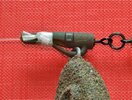"arguable"? "back in the day"? "traditionally"? No Chris, I believe you've got it wrong, and your 'slip is showing'. If fish safety is your priority then, having a hooklenth of a lower breaking strain than anything up-line of it, is undoubtedly and unarguably necessary. This isn't debatable, questionable, or arguable. If you suffer a break when connected to a fish then this break needs to be at the hook, or on the hooklength. This is not 'old thinking' or from "back in the day", and it is not a method used out of habit or due to "tradition". It is used by anglers who place fish care above 'success'. I believe we can learn a hell of a lot from carp anglers (and Match anglers too), but we can't blithely cast out intrinsically unsafe rigs just because they've worked for us when fishing for carp. That is lazy thinking, 'force of habit', and small-minded parochialism to my mind. And it is wrong. Barbel anglers that use free running rigs are not being old-fashioned, they are putting fish safety first and not blindly/unthinkingly adopting the latest rig/rigs of the carp world's icons and demigods.
Strong words maybe, but I stand by them.

